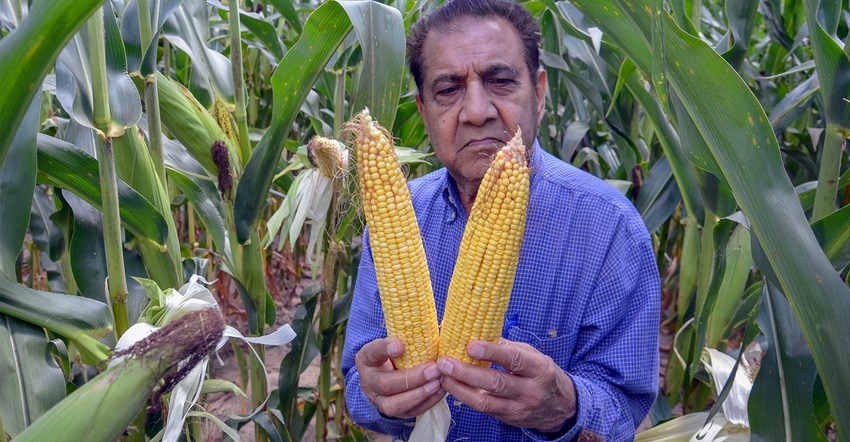
The grower who participates in Crop Watch ’17 prefers to put one hybrid seed in 12 rows of his 24-row planter and the seed of another hybrid in the other 12 rows. He believes it helps him spread pollination risk. So if you’re scouting a field with two hybrids, how can you tell where one hybrid stops and another begins?
“There are several traits you can look for,” says Dave Nanda, an independent crops consultant based in Indianapolis. “Even two hybrids with similar relative maturity ratings can vary in appearance in significant ways.”
Corn Watch ’17 is sponsored by Seed Genetics-Direct, Washington Court House, Ohio.
Key traits
Here are five traits you can use to determine which hybrid is which.
1. Ear characteristics. In the Corn Watch ’17 field, Hybrid A typically produces ears with 16 rows of kernels around, and Hybrid B generally produces ears with 18 kernels around, if conditions are favorable. Row number can be influenced somewhat by environment, but it’s highly tied to genetics, Nanda says.
Breaking each ear into halves, Nanda noticed that Hybrid A has a narrow white cob. Kernels are deeper compared to Hybrid B. Hybrid B’s cob is red.
2. Plant height. Looking in the break where one hybrid ends and the other begins, it’s easy to see that plants of one hybrid are generally taller than plants of the other hybrid, Nanda says. Actual plant height may vary somewhat depending upon soil type and growing conditions, but relative plant height from one hybrid to another should be constant, he observes.
3. Ear placement. In this case, ears of Hybrid B tend to be positioned lower on the stalk compared to ears of Hybrid A, Nanda reports. “I prefer a medium ear placement compared to a high ear placement,” he says. “When ears are positioned higher on stalks, lodging could be more of an issue.”
You need to look at several plants, not just one, to get a feel for ear height for the hybrid, Nanda adds. In this case, there was variation in ear height from plant to plant within both hybrids.
4. Plant color. Looking down the middle between these two hybrids, Nanda concludes that plants of Hybrid B are darker green than plants of Hybrid A. Whether or not you can pick up this difference may depend on how many cornfields you have walked, plus how striking the difference is between hybrids.
5. Disease susceptibility. Some hybrids have more resistance to specific diseases than others. If one of the hybrids happens to be more susceptible and diseases are present, you may be able to determine which hybrid is which by the amount of disease present.
About the Author(s)
You May Also Like




